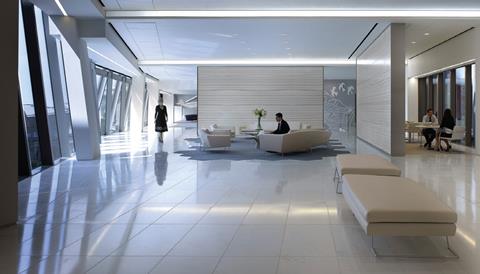
If you read nothing else, read this….
- A well-designed workplace can support employee wellbeing, enhance productivity, and help to attract and retain key personnel.
- Adequate lighting, space and temperature control are employees’ must-haves in a workplace.
- Involve employees: by understanding what matters to them and what they need, changes are more likely to be successful.
For Helen Nichol, director of strategy and business transformation at creative consultancy SoVibrant, the key to creating the optimum workspace is to understand how employees will use it. “Open plan used to be all the rage, but this often had absolutely no bearing on what employees did, so people hated it,” she explains. “Making the working environment somewhere that supports what employees need to do, and makes them feel cared for, will make them happier and more productive.”
Gaining this understanding has led to much more creative workspaces. For example, when Nichol worked with York Council to bring together its employees within one office, staff consultations demonstrated the need for appropriate spaces to accommodate everything from part-time clerical duties through to making confidential calls about child welfare. “Employees now have a variety of workspaces to choose from to suit the work they’re doing,” adds Nichol. “These include private spaces as well as more relaxed areas if they need to take a break or read a report.”
Make a statement
Workspace design can be used in other ways too. Elina Grigoriou, managing director of Grigoriou Interiors, explains: “[An organisation] can market itself through the way its workspace is designed; a technology organisation may want to look fun and creative, while an accountancy firm will look to be more professional. This can help attract the right staff but will also reinforce the [organisation’s] values.”
This approach can also be used to create moods in different areas or rooms. For example, using bright colours could encourage creativity, while softer blues and purples can create a calmer environment that might be appropriate for more serious meetings.
The features within a workspace can also influence employee wellbeing. While there is an obvious link with gyms and exercise rooms, some employers are incorporating services such as nail bars, dry cleaners and hairdressers into the workspace. This can be really successful, says Hazel Carter-Showell, managing director and business psychologist at Carter Corson. “Getting your nails or the dry cleaning done can eat into an employee’s weekend, so they really appreciate having these services onsite. This blending of work and life also suits many employees, especially the millennials.”
There are also plenty of examples of more quirky features. Google is famous for its wacky office design, which includes a 1960s caravan for a meeting room, hammocks and a ball pit for employees. Closer to home, Sheffield’s Electric Works hit the news when it unveiled its 80-foot-long transparent helter skelter, allowing employees to whizz from the third floor to reception in seven seconds.
Carter says these more off-the-wall features can be great for firms that want to encourage creativity. “These types of fun things can get employees into a mindset where they can play and come up with ideas,” she says. “They do have to be appropriate, though: no one wants to have a one-to-one with their boss wearing a sombrero [sitting] on a space hopper.”
Design basics
While businesses are constantly pushing the boundaries when it comes to design, there are some features that are considered necessities. For example, when the British Council for Offices (BCO) conducts research into what matters most in the workplace, the top three answers are adequate lighting, space and temperature control. Richard Kauntze, chief executive of the BCO, says: “These are surprisingly conventional, but it demonstrates that getting the basics right must be at the heart of any office development, renovation or ongoing management.”
Light is a great example of this. Seasonal affective disorder is a form of depression that can affect people during the darker winter months, so exposure to daylight, even simulated daylight, can be a major bonus. As a result, the BCO’s guidelines stipulate that an office should provide sufficient daylight for between 55% and 80% of the typical 9am-5pm day.
But whether employers are planning to change the colour scheme in the workplace, embrace hot-desking or install a helter skelter, it is essential to talk and listen to employees first, says Kauntze. “By putting office occupiers at the heart of workplace decisions, it gives businesses the strongest opportunity to create an environment where the workforce is happy and productive.”
Viewpoint: Motivating employees naturally

In the current economic climate, every employer is looking for ways to motivate its workforce, boost productivity, inspire creativity and, ultimately, improve its bottom line.
Interestingly, there is a real business case for the benefits of incorporating natural elements into office design. Known academically as biophilia, the concept describes the biological and psychological need we have to be continually connected to nature. For organisations that take this approach, the gains – in terms of employee motivation and productivity – can potentially be huge.
The impact of biophilic design on employees is well documented through a growing body of research. The study carried out by Interface and Robertson Cooper in the Human Spaces report, The Global Impact of Biophilic Design in the Workplace, published in March 2015, found that incorporating natural elements into office design increased workers’ wellbeing by 15%, productivity by 6% and creativity by 15%.
Large organisations, such as Google and Apple, are already setting the global standard for workplace design. Not only do their flagship offices embody their external brands, they also provide their employees with a motivational space to work. A significant part of this is the incorporation of natural elements in the design, which creates that beneficial connection to nature.
Geoff Dutaillis, group head of sustainability at Lend Lease, summed up the importance of the building environment to employees in the World Green Building Council report, Health, Wellbeing and Productivity in Offices: The Next Chapter for Green Building, released in September 2014, saying: “Whatever business you are in, you are in the business of people. How a building ‘works for people’ should be the priority question.”
Businesses across the world are fighting to not only keep their employees motivated to produce the highest calibre of work, but also to attract the top candidates in their sector. To stay ahead of competitors, organisations must prioritise employee wellbeing, ensuring all aspects of the brand, both internal and external, appeal to their happiness, creativity and productivity.
Sir Cary Cooper is professor of organisational psychology and health at Manchester Business School, University of Manchester.
Case Study: K&L Gates mixes disciplines

Before moving into its offices in London’s One New Change in 2011, legal firm K&L Gates’ 250 London employees were based in an 11-storey building on Cannon Street, with each floor housing a different department.
Tony Griffiths, administrative partner at K&L Gates, explains: “The way the office was set out meant there was limited mixing and interaction between departments. So when we were given the opportunity to move to One New Change, we decided to overhaul this more rigid departmental-based structure by mixing up the different disciplines.”
Although there was resistance to the idea initially, the way the new offices were designed made it easier to implement this approach. Working with architects Lehman Smith McLeish, the firm transformed its new 10,000m-square office into a workspace, incorporating views over St Paul’s Cathedral with practical features such as meeting rooms and a 180-seat conference suite.
With most of the office space on one of the two floors, the plan to mix up all the different departments was put into action. And although there was still some resistance, it only took a few weeks to win the cynics over.
“One month after we moved in, we won the biggest real estate mandate of the year,” says Griffiths. “This was entirely down to the new working arrangements. By enabling our people to work alongside one another, they have a better understanding of the areas we cover and therefore are much better equipped to communicate this to our clients. As a result, we’ve since won many more cross-disciplinary mandates, and have achieved a 60% increase in revenue and a 62% increase in productivity.”
















